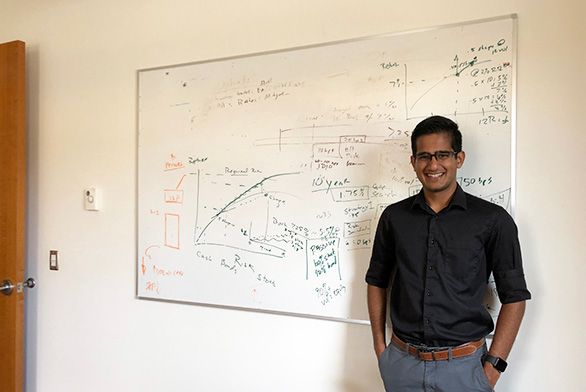Meet the Johnnies: Avinash Kumar (A21)
July 8, 2019 | By Kimberly Uslin

Avinash Kumar (A21) is a rising junior and a recipient of a 2019 Ariel Internship with the New Mexico state pension fund, which covers approximately 100,000 public employees in the state. This fall, he will transfer from the Santa Fe campus to Annapolis.
This summer, you’re working as an intern at the Public Employees Retirement Association (PERA) in Santa Fe as part of the ARIEL Internship Program. What sort of work are you doing?
[PERA] is essentially the state pension fund for about 100,000 public employees in the state. So that means that municipal firefighters, police officers, and all those are employees are covered by the same benefit plan, and the objective of the internship is to figure out what could go wrong and to make sure that things don’t go wrong. As a pension fund, we’re required to achieve a certain grade of return, which is roughly 7.25 percent. The current capacitive investment opportunities can only get us up to 5.5 percent, so we’re trying to bridge the gap between what we have and what we should have.
As a Johnnie, this internship has been perfect because doing work here means you’re at the forefront of academic and professional research and finance. And once you’re at the forefront, you get to shape the future of not just the pension fund, but also traditionally held beliefs In financing. This is a great opportunity to dig into really complex material and to solve problems using original, unconventional thinking—things that a finance major, for instance, might not necessarily have. As Johnnies, our whole idea is to break out of prejudice in whatever discipline we’re in, and that kind of original thinking has proven to be insanely useful. More Johnnies should consider finance; the world needs more of [us] to upend traditionally held beliefs.
What brought you to St. John’s?
I found out about St. John’s through the Colleges that Change Lives website. It’s essentially a list of 40 awesome liberal arts colleges in this country. I just went down the list from A-Z, and I stopped looking at “S.” This was what I wanted—an interdisciplinary liberal arts education.
You spent your first two years in Santa Fe and are going to spend your final two in Annapolis. What do you see as the advantages of each of the campuses?
I went to high school in Singapore and it’s insanely hectic there; just really busy. I wanted to try to find an environment in which I could chill out for a bit, take things easy and focus on my education. Santa Fe seemed like the perfect spot for it, and it still is. The sky’s always blue, it’s always calm and peaceful. It’s a great place to think about the greatest thinkers.
I feel like Annapolis is a good option for me at this stage in my life as I’m starting to look for internship and business opportunities. Annapolis seems to offer that part of the balance—putting the great books to the test in DC, or Baltimore, or anywhere, really.
What parts of the St. John’s Program have been particularly helpful?
This is going to be a really weird example, but reading Descartes as part of sophomore math has been super helpful in understanding algebra. Instead of just blindly doing the math, we’re asked to really look at the variables and the constants—what they mean—and give the math a second look. That’s a very direct application.
A more indirect application would be learning Greek freshman and sophomore year. In the finance world, we’re expected to learn new things almost every day. When you’re on the clock, you have the pressure to perform and to learn new things quickly. Learning Greek was helpful because it’s all super unknown to all of us. St. John’s really helped me understand how to learn new things quickly and how to pick up languages. And by languages, I don’t just necessarily mean spoken and written—I mean things like financial language, with terms and concepts that we don’t know. Because we take the structural approach to learning Ancient Greek, we’re more comfortable.

